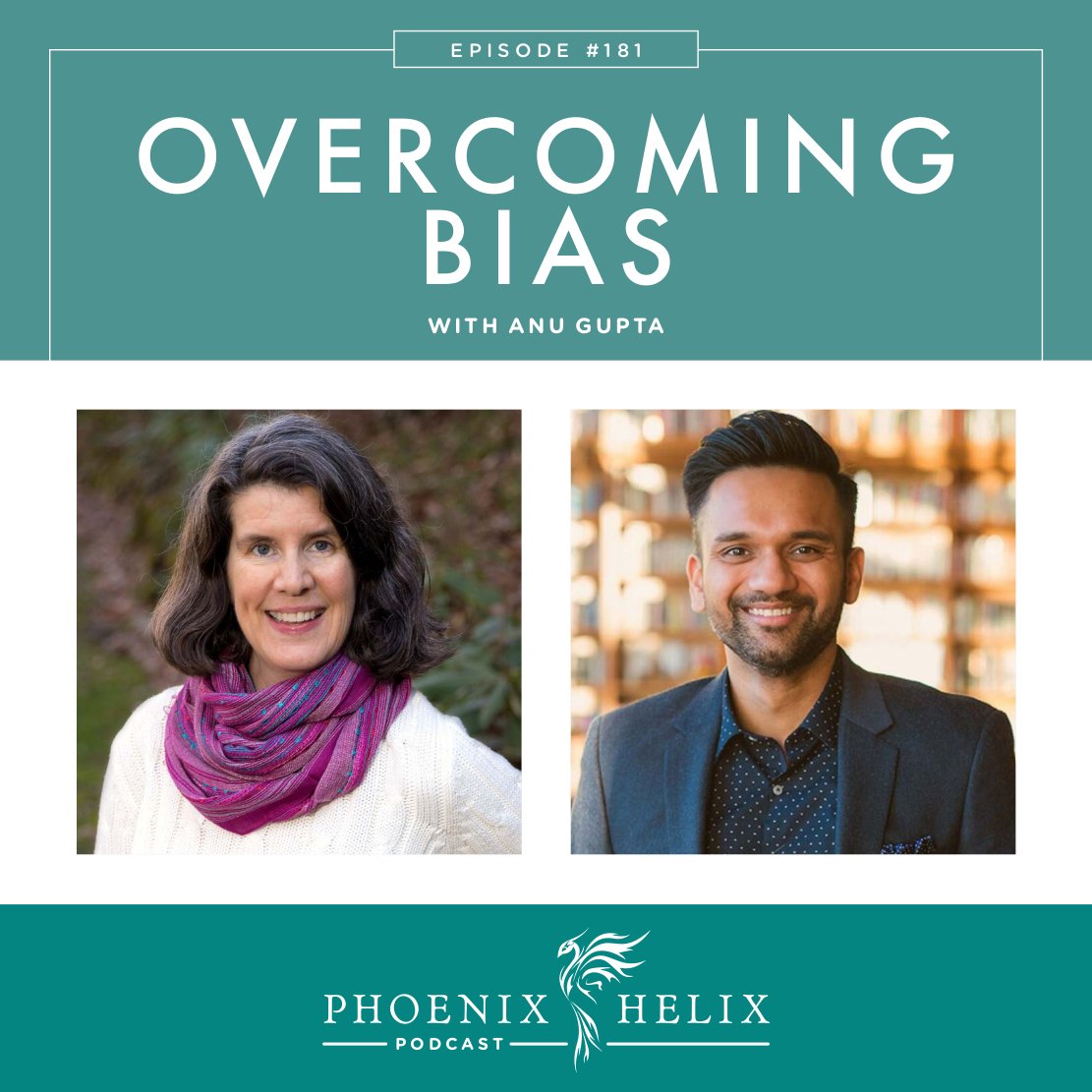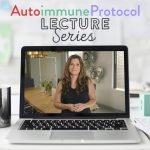Self-Care + Community Care
One thing I love about the autoimmune community in general and the Phoenix Helix community specifically is that we care deeply about each other. We lift each other up, with the goal of living our healthiest and happiest lives. Health involves both self-care and community care, and today’s podcast is a blend of the two. I’ve talked about the impact of racism in two prior podcasts. Episode 153 focused on racism in healthcare. Episode 178 focused on racial trauma. In both episodes I mentioned that overcoming our own internal biases can be a powerful first step in helping overcome racism within our society. There is much beyond our control, but this is something we can change. We’re approaching this conversation with love rather than judgment. My guest is Anu Gupta. He’s developed a compassion-based, scientific approach to overcoming bias and addressing the root causes of racism and other inequalities within our culture. He is a research scientist and educator, and simply a warm, wise and wonderful person.
Listen to the Show
- Subscribe to my podcast through your favorite podcast app: iTunes, Stitcher, Google, TuneIn, Spotify, Amazon, etc.
- You can also listen to the episode right here through the player below, and if you subscribe to my newsletter you’ll get notified of future episodes.
Podcast: Play in new window | Download
Show Notes
- Intro (0:00)
- Thank You to Our Podcast Sponsor – ShopAIP (2:23)
- Today I’m highlighting their bundles. They’re a great way to sample their products by theme. They have a Bakers Dream Bundle which includes a variety of AIP flours. Their Meat Bundle includes some of my favorite meat protein bars and snacks. Savor the Flavor features AIP-friendly spices. Snack Attack is a variety of chips, cookies, and dried fruit. And the Phoenix Helix Bundle is curated by me and contains some of my favorite pantry items.
- ShopAIP is an online store dedicated to the Paleo Autoimmune Protocol. With hundreds of items for the elimination phase of the AIP, and new products labeled by reintroduction category as well. You can find protein bars, sauces and condiments, AIP-friendly spices, cooking and baking ingredients, waffle and pancake mix, delicious snacks, and more.
- If you’re a first-time customer, use the code PHOENIX for 10% off your order. Purchase here.
- Meet Anu (3:32)
- Anu Gupta is a research scientist and educator, who teaches courses to help people overcome their unconscious biases.
- Anu is from India originally. He moved to the United States when he was 10 years old and went from a country where he looked like everyone else, to a country where he was in the minority. It was his first experience being different and being called hurtful names based on how he looked. His coping mechanism was to pursue academic and professional excellence. It was unconscious at the time, but he was trying to get external proof of his worthiness. As an adult, he fell into a deep depression where all of this came to the surface.
- Simultaneously, when he was in law school, he worked with a judge who he knew to be a good person. Yet in court, that judge would sentence black teens to years in jail for petty offenses. It was cruel, and it didn’t make sense.
- The combination of his personal and professional experiences changed his career trajectory to study unconscious bias. Why are human beings prone to it, and how we can overcome it?
- A Compassionate Approach to a Triggering Topic (7:52)
- There’s a lot of defensiveness surrounding the idea of unconscious bias. No one wants to believe they have internal biases that impact how they treat other people.
- Anu’s educational approach takes this into account. It’s based in compassion, not shame. People cannot learn unless they feel psychologically safe, so he strives to create that feeling of safety in his courses. He wants people to feel free to ask questions without fear of judgment, and to explore their own biases without feeling shame.
- Every human being on the planet has encountered bias. It might be about race or gender, but it can also be about height, weight, or chronic illness.
- Anu’s approach addresses both the right and left brain, both the heart and mind. The curriculum is grounded in neuroscience and facts, but also encompasses tools and techniques that use the power of emotion. The goal is to re-learn habits and ways of being in the world, to be able to behave in a way that’s more aligned with our true values.
- PRISM – 5 Tools for Overcoming Unconscious Bias (12:19)
- Perspective Taking
- PRo Social Behavior
- Individuation
- Stereotype Replacement
- Mindfulness
- What’s the Difference Between Explicit & Implicit Bias? (12:40)
- Explicit bias is conscious – people are aware of their biased beliefs.
- Implicit bias is unconscious – people are unaware. It’s learned habits of thought that distort how we perceive, reason, remember, and make decisions. Our brains are wired to unconsciously associate certain character traits with certain human beings. It’s a result of cultural conditioning.
- The vast majority of discrimination in our society is due to implicit bias. Explicit bias has improved over time; implicit bias has not.
- We Can Have Unconscious Bias About Ourselves (16:24)
- Bias doesn’t only arise in relation to other people; it can impact how we view ourselves.
- Even though Anu had a vision for his company and the impact he could have on the world, he didn’t think he could lead it. People in the diversity/equity/inclusion field didn’t look like him. They weren’t Indian-American millennials with a background in law and neuroscience. He had to break his own biases about himself, in order to believe in himself. It continues to be a daily practice.
- Bias & Social Media (18:23)
- There are things about social media we can’t control and those are the automated algorithms. They feed us posts and videos which echo our own beliefs and reinforce our biases.
- However, we all have free will, and there’s a huge diversity of stories being shared on social media. We can seek out and listen to stories of people who are different from us, and when we do that, we can use social media as a tool for breaking bias.
- The Harvard Implicit Association Test (19:51)
- The test is available online and measures the strength of your implicit (unconscious) associations about different groups of people.
- There are 14 different tests you can take, which measure unconscious bias based on gender, race, age, religion, disability, weight, sexual orientation, etc.
- Millions of people have now taken these tests, with over 1000 research studies conducted, and over 150 articles published in peer-reviewed scientific journals.
- That said, this is just one instrument, and your results aren’t static. Many things can affect an individual’s test results, from hunger to fatigue to your personal experiences that day. But as a research tool studying society overall, analyzing all test results together, it shows trends in bias over time. For example, 70% of people who have taken the test had an easier time making positive associations with white faces and negative associations with black faces. Being able to measure bias gives us the opportunity to manage and overcome it.
- Research Summary: The Bias Beneath: Two Decades of Measuring Implicit Associations.
- Can You Permanently Overcome Unconscious Bias? (24:56)
- The Harvard test shows that individual bias measures can change.
- Anu believes this change can be permanent, but it’s not a quick fix. It takes time to rewire our brains in new directions. It’s a daily practice, and he’s developed a protocol that people can use to achieve this (The PRISM tools mentioned above).
- Just 1 minute of daily practice with bias-breaking techniques can make a positive difference. And if you miss a day, start again the next day. Anu puts it in the same category as brushing our teeth. It can become a habit.
- Breaking bias begins with simply noticing the stereotypes that arise in your mind when you see a person in the media, or meet a person in real life. Don’t judge what arises – just notice. Then you can consciously choose to set aside those stereotypes and be open to discovering who this person really is, rather than letting bias guide your opinions and interactions.
- Personal Benefits of Overcoming Bias (28:26)
- When we start to notice our own biases, we have the power to change them. Instead of having our thoughts and behavior controlled by cultural conditioning, we can consciously choose how we want to be in this world. It’s an act of free will.
- The same practices that break bias also help create inner freedom. They help us manage stress and support our mental health. That’s why it’s a combination of self-care and community care. When you embark on a journey to break your own unconscious bias, it doesn’t just open up deeper connections with others, it also opens up a deeper connection with yourself.
- Thank You to Our Podcast Sponsor – The AIP Lecture Series by Dr. Sarah Ballantyne (30:20)
- Most of you know and love Sarah. She’s considered the leader of the Paleo AIP community, and she’s a favorite guest on this podcast. She’s gearing up to teach another session of her amazing online course, the AIP Lecture Series.
- This course is designed for autoimmune disease sufferers and caregivers. Over 6 weeks in her virtual classroom, Dr. Sarah teaches the scientific foundation behind the Autoimmune Protocol, and also provides tons of tips for implementation, troubleshooting, and mindset.
- She crafted the course to be accessible in all time zones, with benefits for all levels of experience. Whether you’re brand new to the protocol or you’ve been AIP-ing for years, this course is for you!
- But the best part is that Dr. Sarah teaches it herself. In addition to the 43 video lectures and printable resources, there’s a private Facebook group where you can connect with her directly. Dr. Sarah personally answers every question posed in that group during the 6-week course session. She also guides twice-weekly discussions within the group and creates a FAQ video every week based on the most common questions.
- Her next class begins on Monday, September 13th, and she’s offering my listeners 10% off with the coupon code PHOENIXHELIX. Register through this link: ThePaleoMom.com/go/aipls.
- Breaking Bias Technique #1: Boosting Mindfulness in Daily Life (32:35)
- Mindfulness is one of the five techniques Anu teaches for breaking bias. It’s simply the act of noticing and being aware of the present moment.
- Many people wonder about the difference between formal meditation and mindfulness. Meditation is a mechanism for strengthening mindfulness. Often, a meditation practice boosts mindfulness in daily life as a side effect.
- Resource: Podcast Ep. 91 – Meditation for Fidgety Skeptics.
- Breaking Bias Technique #2: Stereotype Replacement (36:17)
- This builds upon mindfulness. Notice when a stereotype arises in your mind. They are usually negative. Then replace it with a positive example.
- Stereotype replacement loosens the unconscious associations that are wired into our brains and creates space for multiple associations, especially positive ones.
- For example, if you see a negative portrayal of a black man in the media, bring to mind someone like Dr. Martin Luther King – also a black man.
- For the stereotype that “women aren’t good at math”, learn about Shakuntala Devi who was known as the Human Computer.
- The goal is to be able to do this in daily life anytime we notice a stereotype arising in our mind. It’s a practice.
- You can help build this muscle by taking time to research people who break stereotypes: Black Physicists, Latinx Economists, Female Chiefs of Surgery, Indigenous CEO’s, Asian Ballerinas, Middle-Eastern Peace Activists, Decorated LGBTQ Veterans, Disabled Race Car Drivers. There are endless possibilities. This is the opposite of “doomscrolling” and can be an enjoyable and inspiring way to spend time on the internet.
- This also supports individuation – another tool for breaking bias. Individuation is the practice of differentiating individuals from group-based stereotypes by cultivating curiosity.
- Breaking Bias Technique #3: Compassion Meditation (42:40)
- Our brain evolved to protect us from danger, and that resulted in a negativity bias. It’s always on the lookout for what may be “wrong” with the goal of keeping us safe. In modern life, fear can get triggered when we aren’t actually in danger. One of the ways that can happen is in response to people who are different from us. Compassion meditation helps shift that negative inclination of the mind, balancing it with more positive emotions like compassion, joy, generosity, and altruism.
- Compassion meditation begins with self-compassion, and then extends outward – first to someone we love, then to someone we like, then to a neutral person, then to someone we don’t like, then finally to the world at large, and even other species (animals and plants).
- When Anu started his compassion practice, he began with self-compassion and did that for several months. For the self-compassion piece, he recommends that we imagine ourselves today, but also as children. When he did his practice, he sent compassion to himself at all ages of his life, from infancy to present day. It helped heal trauma from those young ages. That laid the foundation for him to be able to extend compassion to others.
- When you first choose a difficult person, choose someone slightly difficult. Don’t go straight to someone who has hurt you deeply, or someone you hate. You can build up to that.
- Most people in the world fall into the neutral category – the people we often ignore – drivers on the freeway, the grocery clerk, the delivery person, a receptionist, a customer service rep., etc. When it comes to breaking bias, choosing people in the neutral category who are different from us can be a powerful first step, especially people from marginalized groups. And you can personalize this according to the biases and stereotypes you start to uncover in your own mind.
- Resources:
- Podcast Ep. 80 – Self-Compasssion.
- Anu has some guided meditations on the Insight Timer app, including two compassion meditations.
- Outro (52:31)
- You can connect with Anu through his website. He has a self-paced online class focused on Breaking Unconscious Bias. He also offers in-depth courses on Breaking Racial Bias that include live virtual classes, professional guidance, and a community of support.
- Eileen (your podcast host) is the author of multiple books, written to help people thrive with autoimmune disease. Learn more on the Books Page.
- If you like this podcast, follow or subscribe through your favorite podcast app. You can also subscribe to Eileen’s biweekly newsletter.
- Check out the entire archive of podcast episodes.
You May Also Be Interested In
Spreading the Word
If you like the podcast, please leave a positive review in iTunes. It would mean the world to me, and also helps others find the podcast. Here are some quick instructions using your iPhone:
- If you are already subscribed to my podcast: (1) Click the purple podcast icon. (2) At the bottom of the screen, click Library. (3) At the top of the screen, click Shows. (4) Click the Phoenix Helix podcast image. (5) Scroll down the page, and you’ll see Ratings and Reviews. Scroll down a little bit more and click on Write a Review. This will bring up the review screen. Tap 5 stars (if you love the podcast), and then click in the title box, and it will bring up the keyboard. Enter a title and short review. (6) Click Send in the upper right corner. (7) Thank you! Positive reviews give the podcast a higher search ranking in iTunes, helping people find it and letting them know it’s a quality podcast and worth their time to listen.
- If you haven’t subscribed to my podcast: (1) Click the purple podcast icon. (2) In the lower right corner, click the magnifying class. (3) Type Phoenix Helix in the search box. (4) Click the podcast cover in the Show list. (5) If you’d like to subscribe, click the + sign at the top of the screen. (6) To write a review, scroll down the page, and you’ll see Ratings and Reviews. Scroll down a little bit more and click on Write a Review. This will bring up the review screen. Tap 5 stars (if you love the podcast), and then click in the title box, and it will bring up the keyboard. Enter a title and short review. (7) Click Send in the upper right corner. (8) Thank you! Positive reviews give the podcast a higher search ranking in iTunes, helping people find it and letting them know it’s a quality podcast and worth their time to listen.








